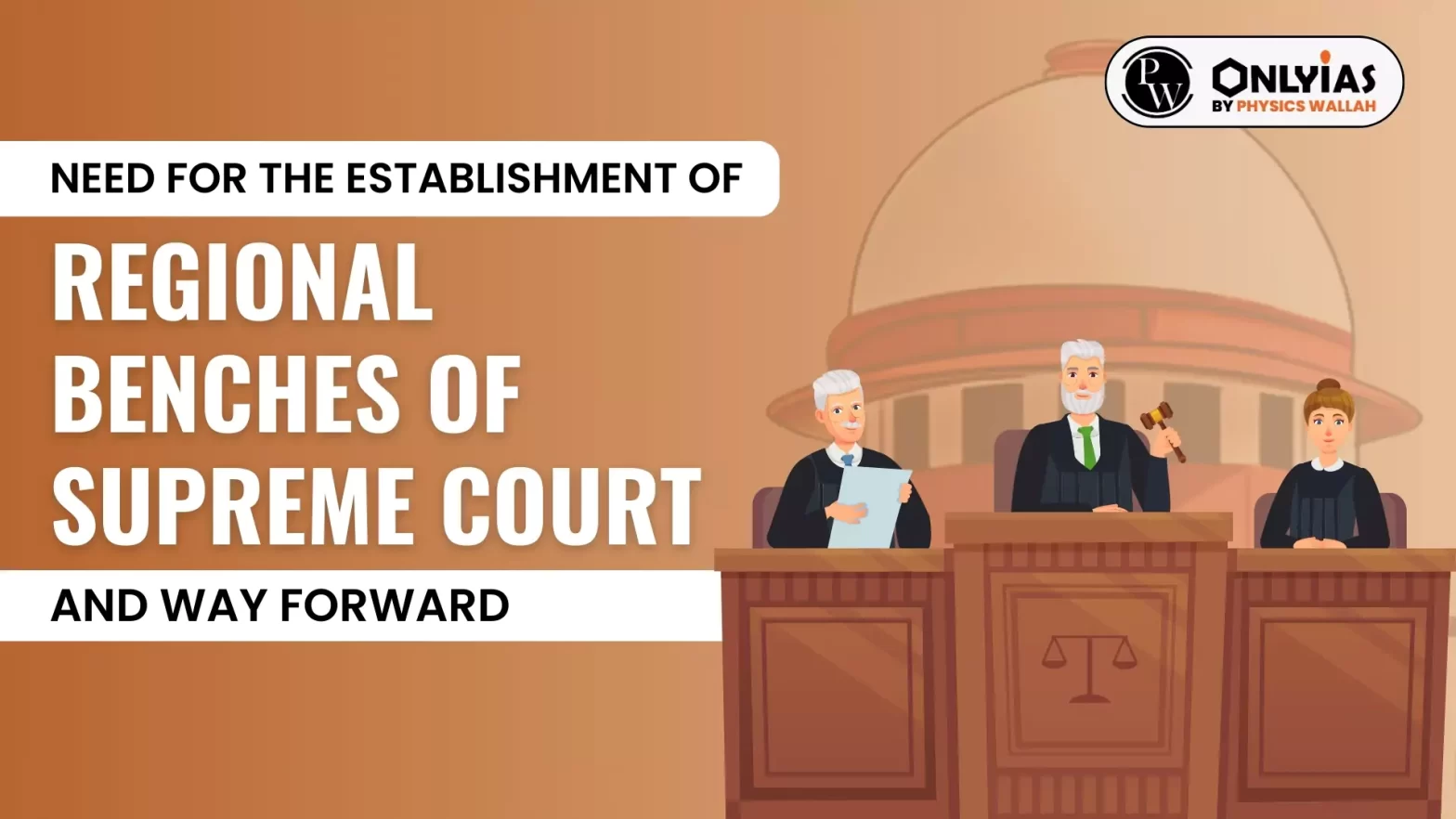Context:
This editorial is based on the news “Should India have regional benches of the Supreme Court?” which was published in the Hindu. Recently, the Parliamentary Standing Committee on Personnel, Public Grievances, Law and Justice said the Law Ministry has accepted its recommendation to establish regional benches of Supreme Court across India. However, the apex court has been “consistently” rejecting the idea.
Need For the Establishment of Regional Benches of Supreme Court
- Increase in Approaching Frequency by the People: People are less willing to accept arbitrary or unjust actions of the state and its agencies and are increasingly approaching courts of law and resulting in demands for further adjudication by the Supreme Court.
- To Counter Geographical Barriers: It becomes practically impossible for people living in States far away from Delhi to agitate their cause.
- It is said that the presence of a litigant is not required in appellate forums but every litigant wishes to visit his lawyer and witness court proceedings involving his case.
- To Boost Judicial System: Currently, there is a high pending adjudication of cases and its alleviation needs efforts and efficiency. The establishment of regional benches will increase the number of judges as well as lawyers and boost the judicial system.
- More Democratisation: The setting up of regional benches would also lead to greater opportunities and the democratisation of the Bar.
- Maintenance of Uniformity: Technology has played a pivotal role in keeping judges updated, which helps to maintain uniformity in decisions.
- The conflicting or divergent views result from the non-availability of effective assistance and sometimes due to a lack of judicial discipline.
| Pros of Having Regional Benches |
Cons of Having Regional Benches |
- Justice would become more accessible.
- It would reduce the burden on the Supreme Court.
- It could solve local issues more effectively.
|
- Different views can emerge and lead to contradictions.
- It could dilute the status of the Supreme Court.
- Infrastructure cost would increase.
- The process of appeal would get complicated.
- Judges may get political influence.
|
Could Virtual Hearing an Alternative to Supreme Court Regional Benches?
- Action Taken: The steps taken by the judiciary since the onset of the pandemic to switch to virtual hearings are laudable.
- Challenge: In many forums such as the Central Administrative Tribunal and the National Consumer Disputes Redressal Commission of India, virtual hearing facilities are not used.
- Many judges also prefer lawyers to be physically present.
- Significance of the Physical Hearing: It helps to maintain objectivity. Open court system plays a vital role in ensuring that a judge maintains the appropriate attitude and demeanour.
- The presence of lawyers and litigants in a courtroom also helps a judge to work without any fear or favour.
- Need for a Hybrid Mechanism: A mechanism should be put in place that allows preliminary and admission hearings to take place virtually, while final hearings are conducted physically.
- Only in Exceptional Cases: While the use of technology is good for judicial administration, court management, and handling the case flow, it is not a viable solution for judicial adjudication.
Way Forward
- Scrutiny of all kinds of Petitions by the Supreme Court: A mechanism should be put in place to scrutinise the types of petitions that are permitted to be admitted in the top court.
- While the top court is indeed overburdened with Special Leave Petitions (SLPs), it would not be correct to have to seek leave from the concerned High Courts or the Tribunals to even lodge an SLP.
- Establishment of a Permanent Appellate Court along with several Courts of Cassation: Similar to France, this system of a Permanent Appellate Court along with several Courts of Cassation (recommended by the Law Commission in its 95th and 229th reports) could be implemented.
- In this system, the chances of conflicting decisions would be reduced, as the court of cassation would only apply the decisions of the permanent appellate court.
- And in divergent views of the courts of cassation, the permanent appellate court may resolve the conflict.
- In the U.S., the permanent appellate court hears only constitutional cases while the cassation courts adjudicate upon appeals arising out of non-constitutional matters.
Cassation Court:
- It is a high-instance court that exists in some judicial systems, which does not re-examine the facts of a case but only interpret the relevant law.
- In this, they are appellate courts of the highest instance.
|
- Proportionate Increase the Number of Judges: The availability of adequate judicial infrastructure varies from State to State. There is a very high pendency of cases which can be resolved by increasing the number of the lawyers and judges in the system.
Conclusion
The idea of establishment of regional benches seems significant, however certain exclusive powers of the Supreme Court should be retained – its original jurisdiction under Article 131, its advisory jurisdiction under Article 143, and its writ jurisdiction under Article 32 of the Constitution.
Also Read: Supreme Court Verdict On Chandigarh Mayor Elections
![]() 23 Feb 2024
23 Feb 2024

